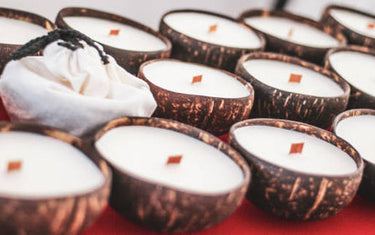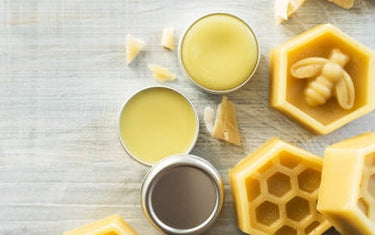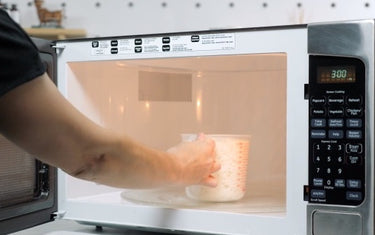5 min read / 23 May 2023 / Laura Garvin Gomez
How to Make Coconut Candles
Coconut wax is the perfect all-natural alternative for your homemade candles. Here's all you need to know about how to use it.
Share this post

In the wellness world, the coconut is the king of all things beneficial.
It has earned significant popularity in oil form as a hydrator for the skin and hair, in milk form for our coffees and cakes, and even in water form as a refreshing beverage by the sea.
In recent years, the coconut has been expanding its influence further still, with many candle makers now using coconut wax to power their scented creations.
Coconut wax candles offer a unique, all-natural alternative to controversial wax types like paraffin, while still providing a great scent throw and an ideal colour base for dyes.
If you're interested in learning how to make coconut candles for your collection, read on to find out just what this up-and-coming wax type can do for you.
What is coconut wax for candles?
Coconut wax is a plant-based wax alternative made from cold-pressed coconut meat. It's seen as one of the healthiest wax types for making candles and is often compared to soy wax in its characteristics.
Coconut wax, unlike some other wax types, has a very clean burn and emits very little soot into the air. It also has a subtle, sweet aroma that easily compliments any fragrance type.
Many candle makers who focus on sustainable practices while candle making like to use coconut wax for these reasons. Learn more about the different wax types used for candle making.
Are coconut wax candles safe?
Coconut candles are perfectly safe to make and burn. As with any form of crafting, there are always health and safety procedures to keep in mind, but these are no different for a coconut candle than for any other candle type you choose.
The only thing to keep in mind when making coconut candles is to store them in the correct environment. Coconut wax has a lower melting point and therefore should be kept in a cool, dry location away from direct sunlight.
Learn more about how to store candles and wax melts correctly.

What are the benefits and drawbacks of using coconut wax for candles?
As with any wax type, there will be certain pros and cons to using coconut over other varieties. We've provided a list of all you'll need to know before using it.
Benefits:
- Coconut wax has a naturally high yield, meaning it takes very few coconuts to create a decent amount of wax.
- Coconut candles have a slower burn time than other varieties.
- Fragrance oils combine well with coconut wax and produce an amazing scent throw.
- Coconut candles tend to have a cleaner burn.
- Little to no frosting.
- Improved glass adhesion.
- Produces vibrant colours when used with dyes.
Drawbacks:
- Coconut wax is softer than more wax types.
- It has a lower melting point, so must be stored correctly.
- In hotter weather, coconut candles are more likely to sweat.
How to use coconut wax for candle making
Coconut wax candles are made in the same way as most other candles, so you can refer to our beginner's guide to candle making for a more in-depth recipe on how to craft your own.
Coconut wax candles offer an all-natural alternative to controversial wax types like paraffin, while still providing a great scent throw. If you're wondering how much wax you need to make candles, check out this guide: how much wax for candles.
If you're already familiar with the process though, we've covered some of the basic steps below:
- Using your preferred method, melt your wax. Most coconut waxes will melt at around 80°C under gentle agitation. It's a good idea, if you can, to constantly mix your wax while it's melting.
- Add your desired fragrance oils or essential oils, as well as any dyes you'd like to use. Stir gently for 2 minutes. You can find a variety of oils for a discount when you sign up for a wholesale account.
- Leave your wax to cool until it reaches 60°C -71°C.
- Make sure your wick is secure inside your candle container. Pour your coconut wax into your candle container.
- Let the candles sit for 24 hours. Once dried, trim your wick to the desired length, and enjoy!
Most coconut waxes will hold a fragrance load of up to 10%, but you can also refer to our candle fragrance guide if you're unsure about your scent percentages.
If you want access to essential and fragrance oils at a discount for candle making, then sign up for a wholesale account with us. Likewise, if you're looking for a new project, explore how to make wickless candles for a flameless, safe alternative to traditional candles.
Can you make candles with coconut oil?
Coconut oil, especially the extra virgin variety, will often look a bit like wax by itself. Coconut oil can't, however, be used solely as candle wax.
Its composition is not as strong as that of coconut wax and your candles will likely melt to a puddle if they rise above a certain temperature - not ideal for a product that requires a flame!
Where coconut oil does come in handy is in the strengthening of your existing waxes. Adding a few drops of any kind of coconut oil to your candle mix will help create a cleaner, healthier burn. It also adds a subtle sweetness that will help bolster your existing fragrances.
Mix your coconut oil into your melted wax before adding any fragrance oils or dyes. You may also have to experiment with a few different oil ratios before you find one that works for you.

Using coconut wax for your candles is not only eco-friendly but also incredibly simple. If you're only just starting out in the world of candle making, be sure to check out our candle making tips for beginners to help set you on the right path.
Whether you’re a small business owner or looking to start a new hobby, we have all the high quality essential and fragrance oils you need for a discount. Sign up for our wholesale to take advantage of our exclusive offers.









